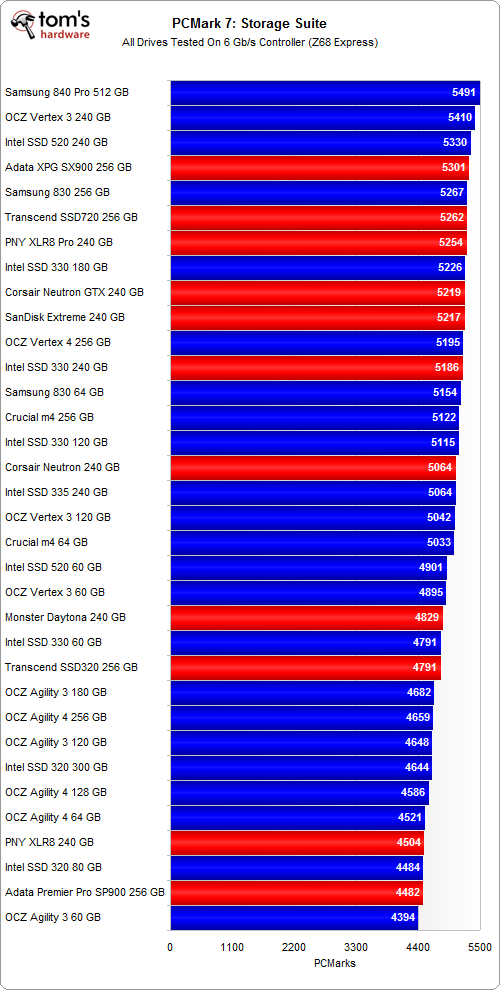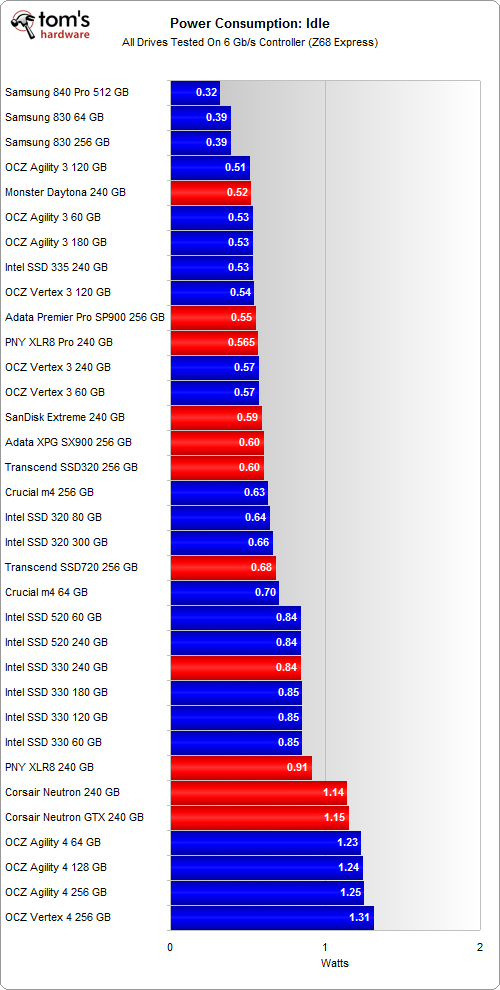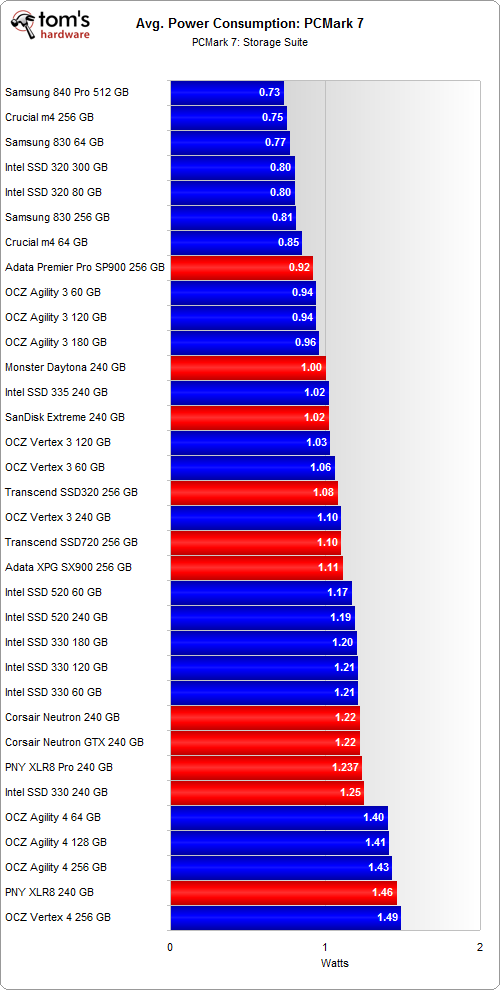Time To Upgrade: 10 SSDs Between 240 And 256 GB, Rounded Up
Over the past year, we've seen the cost per gigabyte of solid-state storage drop in a major way. Once upon a time, we shopped for affordable 60 and 80 GB drives. Now we really want 256 GB drives in our desktops. Meet the last 10 models to land in our lab.
PCMark 7 And Power Consumption
PCMark 7’s Storage suite involves quite a bit of compressible data. As a result, the SandForce-based SSDs put up a pretty good fight.
However, the general performance hierarchy we like to use persists when it comes to categorizing NAND interfaces for a given controller. For example, the Adata SX900, Transcend SSD720, PNY XLR8 Pro, and SanDisk Extreme SSDs all jump to the front of the SandForce grouping thanks to either synchronous or Toggle NAND. Meanwhile, the drives equipped with asynchronous NAND fall to the bottom of the ladder, just as we'd expect.
It's also interesting to note that PCMark 7 puts Corsair's Neutron GTX right on par with those drives, beating out OCZ's Vertex 4.
Because SSDs are so fast, they sit idle most of the time. In almost our almost-30-minute virus scan, the SSD was only busy for 281 seconds. As a result, idle power consumption is the most important figure to consider in a desktop environment.
We've already seen Samsung's drives fare particularly well in idle power measurements, despite their beefy triple-core ARM-based controller. The 840 Pro is our top finisher, followed by a couple of different 830s.
The SandForce-based SSDs fall within a pretty tight range, though. Again, we expect this. Although SandForce's drive partners implement their own power circuitry designs, they're all engineered from a single reference.
It's interesting that the SSD 330 240 GB, which we're testing for the first time today, uses so much more power at idle than Intel's SSD 335 240 GB, which we reviewed in Intel SSD 335 240 GB Review: Driving Down Prices With 20 nm NAND. Perhaps this is a result of Intel's shift to 20 nm NAND, or maybe there really were some optimizations made to the power circuitry.
Get Tom's Hardware's best news and in-depth reviews, straight to your inbox.
Corsair's Neutron drives, which we're looking at for the first time today, consume more than 1 W while idle in PCMark 7's Storage sub-test. They're better than OCZ's power-hungry Vertex and Agility 4 drives, but they more than triple the power use of Samsung's 840 Pro.
The power chart gets reshuffled a bit when each drive is hit with a workload, and there's less difference between opposite ends. PNY's 240 GB XLR8 drive consumes the most power of our SandForce-based models, though the 256 GB Vertex 4 is an even more egregious consumer.
Corsair's Neutron and Neutron GTX aren't far behind either XLR8 drive, or Intel's 240 GB SSD 330. That's the wrong end of our power measurements. Adata's XPG SP900 fares much better, even besting the improved 240 GB SSD 335.
Current page: PCMark 7 And Power Consumption
Prev Page Test Setup And Benchmarks Next Page Real-World Write Testing-
mayankleoboy1 get the cheapest, biggest you possibly can. Benchmarks exaggerate the difference between SSD's.Reply -
A Bad Day I agree. Unless if you're buying a glorified USB stick (there is a 128 GB stick) or an SSD with an OC'ed processor, the main factor that consumers should be concerned about is price per gigabyte.Reply -
A Bad Day EDIT: And reliability.Reply
"In order to install a new firmware that significantly boost performance and stability, you must backup all of your data because it will be wiped." -
Tanquen Yea, it’s getting a little out of hand. For 90% of the things 90% of people do on their PC, 200MBs+ read and write speeds just don’t mean much. There are too many other bottle necks going on. I messed around with a RAM drive using most of my 64GB of RAM and the read and write speeds are fun to test (4000MBs or so) but games and VMware sessions I launched from the RAM disc saw no noticeable improvement in launch times or anything else. Same goes for my 830 SSD drive. It’s fast but games and software I use for SCADA development just don’t see any real benefit. They are cool if you want to open 10 sessions of MS Word and 15 Internet Explorer and a bunch of other stuff at the same time but if you just open one instance of Excel and use it and the Photo Shop and use it and then a web browser and use it, you’ll never really see the difference. You have to benchmark it or have two PCs setting right next to each other to see that something started or saved a split second faster.Reply
At least with my 64GB of RAM and actually get 64GB of RAM unlike HDs and SSDs.
-
tomfreak unless the sandforce drive is priced a lot cheaper than the similar capacity non-sandforce SDD. I always choose the non-sandforce SSD. 16GB is a big deal in SSD.Reply -
stoogie until theres affordable 512gb ssd's then i wont get 1, my c drive is 360gb~ and i have 11tbReply -
sna TanquenYea, it’s getting a little out of hand. For 90% of the things 90% of people do on their PC, 200MBs+ read and write speeds just don’t mean much. There are too many other bottle necks going on. I messed around with a RAM drive using most of my 64GB of RAM and the read and write speeds are fun to test (4000MBs or so) but games and VMware sessions I launched from the RAM disc saw no noticeable improvement in launch times or anything else. Same goes for my 830 SSD drive. It’s fast but games and software I use for SCADA development just don’t see any real benefit. They are cool if you want to open 10 sessions of MS Word and 15 Internet Explorer and a bunch of other stuff at the same time but if you just open one instance of Excel and use it and the Photo Shop and use it and then a web browser and use it, you’ll never really see the difference. You have to benchmark it or have two PCs setting right next to each other to see that something started or saved a split second faster.At least with my 64GB of RAM and actually get 64GB of RAM unlike HDs and SSDs.Reply
to see the difference you will need to put the system itself on RAM Disk. not only the installed programs.
-
Where are Samsung SSDs ? Especialy model Samsung 830- 256GB which is on sale in Europe for 160-180€. That is best offer, reliable, faster than basic 840. Get some MB with Z77 chipset and you can RAID them with TRIM support. 2x256 for 330€ is so awesome with 1035Mb/s read in RAID 0. I tested it on Gigabyte Z77-UP4 TH, its a shame that there are only 2x6Gbit ports so 1x840 Pro + 2x830 in RAID 0 is impossible on this MB without SATA2 speed loss on remaining SATA ports. This was my scenario for fast gaming /500GB Steam inventory/ : Raptor, later RAID 0 HDDs, later Velociraptor, next 128GB SSD + 1GB Samsung HDD cached by OCZ Synapse 64GB /totaly unreliable/. So I ended up with 1x boot SSD + 2x SSD in RAID 0. Maybe I am little bit offtopic but any ideas how to "live" with increased Steam inventory and keep it fast enough ? Steamover SW is not reliable for me. Thanks for nice article.Reply
-
ojas ReplyWhen Thomas, Don, and Paul prioritize the parts for their quarterly System Builder Marathon configurations (the next of which is coming soon, by the way)
Wait, SBMs are fine, but where oh where went BestConfigs? -
-Fran- I went for a Vertex4 and placed it in my notebook. What a boost. I'd say it also helped improve battery life.Reply
For a Desktop, I don't have a particular use TBH. I have a RAID0 with 2x512GB WD's and it works amazingly good (and fast as well). I'd say, for desktops, SSDs are still not viable because of price, unless you clench your teeth with loading times or such, hahaha.
Cheers!


